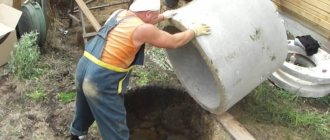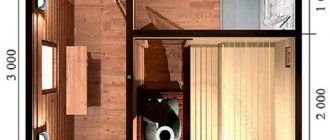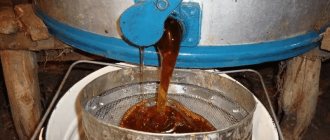A bathhouse, first of all, is water, without which you cannot wash and which after washing must be somehow disposed of, drained, without flooding the entire surrounding area. This means that we need an effective drainage system, a drain for the bathhouse, which on a “bath day” will allow it to function for at least half a day and provide washing for even a large family.
View this publication on Instagram
Publication from Wooden houses and baths from KELO (@artkelo)
Drainage system in the washing room
Washing room in a bathhouse with a leaky wooden floor
Traditionally, a Russian bathhouse consists of two rooms - a dressing room and a steam room, combined with a washing room. The layout of modern analogues of Russian baths is represented by such premises as:
- the waiting area;
- washing room;
- steam room
The first room does not require drainage. The technology for drainage in washing and steam baths depends on the type of floor in a particular room.
Typically, the floor in a bathhouse comes in several types:
- pourable - a lag floor structure used in regions with a relatively warm climate and sandy soil. The plank flooring is laid with a small gap, which ensures unhindered drainage of waste water directly into the ground. In the central regions of Russia it is practically not used
- leaky - a wooden plank floor with a structure on logs, fixed to the supports of the load-bearing base or the lower crown of a wooden frame. The drainage drain is mounted at the lowest point of the floor, where dirty water flows after seeping through the gaps between the floorboards. Optimal design for baths on a columnar foundation;
Washing room in a bathhouse with a concrete floor and grated flooring
- non-leaking - a monolithic and sealed concrete floor, poured with a slight slope towards the center or the far wall of the room. In the first case, the drain ladder is mounted directly into the concrete screed. In the second, along the edge of the wall there is a drainage chute connected to a drain. A non-leaking floor is installed in bathhouses and saunas on a strip-type base.
With the exception of the pouring floor, the internal part of the drainage system is represented by a drain for collecting water and a drain pipe. The outer part of the sewer system, depending on the size of the building, the type of soil, and the depth of soil freezing, can have a different appearance.
For a small bathhouse used once a week, a simple drainage system with a small drainage hole located under the floor structure or in close proximity to the building is sufficient. For a bathhouse designed for a large family, which can be heated once or twice a week, a more complex sewer system with a drainage well will be required.
Step-by-step guide to creating a bathhouse drain with your own hands
About 90% of Russia's territory is located in a climate zone where in winter the temperature is guaranteed to drop below minus five degrees. Therefore, the drainage system for drainage water will most likely be connected to a sump well, less often to a drainage well with the ability to filter drainage water through a ground bed, as well as to septic tanks or, if there is a developed municipal infrastructure, to connect the drainage system to a stationary sewerage system.
Therefore, there is no point in considering pits under the washing compartment or steam room in this case: such a bathhouse cannot be used in winter due to freezing of the soil and the inability to absorb water into its lower layers, which are below the freezing point or groundwater level.
So, a sump well, a septic tank or a sewer. What steps should be taken step by step to ensure that the bathhouse drains correctly?
Installation of the internal part of the drainage system
- Trenches are dug with a depth of 40 to 60 cm for laying drain pipes, with a slope of 2 cm for each linear meter. The bottom of the trenches is covered with sand, the sand is compacted while maintaining the required degree of slope.
- A drain system is installed with all the necessary adapters in the form of corners, tees, etc., with sealing of joints, if this is included in the technological minimum according to the instructions.
- A sewer riser is installed, secured to the wall with special clamps, if the bathhouse has a toilet. In addition, the riser is either equipped with a ventilation well with an outlet above the roof, or it is cut off above the level of the toilet cistern and a check valve is installed on the cut-off part.
Installation of a closed septic tank
A septic tank for collecting wastewater can be either homemade, made from scrap materials (even car tires placed flat on top of each other), or produced at a specialized enterprise. With a ventilation “trunk”, a hole for connecting a drain pipe, a shaft for the corrugation of a sewage disposal machine. Moreover, if the wastewater drained into it does not exceed a volume of 300 liters at a time, and 700 liters per week, then it is quite possible to settle on a septic tank made from tires.
The height and base area of the septic tank depend on the type of soil on which it is placed. Sandy ones have the greatest absorption capacity - 100 l / m2 / day. On mixed soils, this capacity usually does not exceed 50 l/m2/day, on loamy soils - no more than 20 l/m2/day.
The procedure for installing a septic tank is as follows:
- A trench is dug from the exit point of the bathhouse drain pipe to the selected location for the septic tank, maintaining the required slope along the entire length of the route.
- After excavating the soil, in an area of 3 x 3 m, they dig a 2 x 2 shaft with a depth of 2.5 - 3 meters, into which tires from heavy trucks (6-8 pieces) are lowered flat sequentially. A hole is cut in one of the top ones for the entrance of the drain pipe.
- The finished septic tank is closed with a plastic or metal lid with a ventilation pipe inserted into it.
- They check the ability of the soil under the septic tank to absorb water, for which up to 100 liters of water are poured inside through a pipe and the time of its absorption into the soil is determined, after which the lid of the septic tank and the surrounding area are covered with the excavated soil.
Installation of a drain well
The most convenient material for a drain well is reinforced concrete rings. They are produced in different diameters and fit perfectly together, for which purpose grooves and protrusions are provided at the ends, ideally matching one another. In addition, they can be equipped with matching bottoms and covers with standard plumbing hatches.
For natural water flow, it is better to place the well under the septic tank in a low area - this way you will have to remove less soil. In addition, there must be a place for the access of a special vehicle that will pump out the accumulated excess drain water. To construct a well, a 2 x 2 m shaft is dug, with a calculated depth.
Precast concrete rings are an expensive thing, so many limit themselves to homemade devices. For example, they use used and even broken bricks to line the walls of a well. In such cases, a sand cushion is poured onto the bottom, compacted, and then a concrete mixture based on cement-500 is poured in, and after the concrete has hardened, finishing of the walls with bricks begins. It is better to use a mixture of clay and sand as a binding solution. After such walls have dried, they are treated with bitumen mastic. As a cover, they either take ready-made reinforced concrete for a well shaft, or cast it from concrete with the formwork placed so that the cover overlaps by 30 cm in length, width or diameter. The filling is made in two layers, with reinforcing rods between them. Such a self-cast slab is also treated with bitumen mastic, and before backfilling with soil it is also covered with polyethylene 200 microns thick.
Installation of a ground filtration system
If there is no low-lying area near the bathhouse that will ensure self-flow of water, then you have to dig a deeper hole for the septic tank. But in any case, it is better to place it as close as possible to the place where the drain pipe exits the bathhouse - this provides a greater guarantee of non-clogging.
A trench 80-110 cm deep is dug at the place where the septic tank is dug. The specific depth of laying the pipe is selected taking into account the level of freezing of the ground.
Drainage pipes are being laid. To make them, holes are drilled in pipes using 8, 10 and 12 mm drills. In this case, the pipeline to the septic tank is divided into three conditionally equal parts, and as you move away from the bathhouse, the diameter of the holes in each of these parts is reduced.
The pipes are laid on geotextiles, which, in turn, are laid on a crushed stone bed. At the end of the pipe, a branch is strengthened with an angle of 90⁰ to the pipe, onto the end of which a protective valve with holes is put on. The pipe is also wrapped in geotextile, and after checking its functionality, it is first filled with 10 cm of crushed stone, and then with ordinary soil.
Tips for use
Drainage pipes require regular cleaning using plumbing fixtures or cleaning products.
The waste container is regularly checked to ensure it is full and emptied in a timely manner. Particular attention to filling is needed in the fall and spring, during periods when the soil is saturated with water and it does not leave the septic tank so intensively. And every 12-15 years it is necessary to completely replace the sand and gravel cushion in the trenches simultaneously with the lower layer of earth underneath them. Polyethylene pipes, whose service life reaches 50 years, do not need to be replaced.
Tips for using water drainage from a bathhouse
If the conditions of slope and evenness of laid drainage pipes are met, there are no problems with their operation. Or they can be solved in the following ways:
- Dirt in the drain. Usually this is hair or remains from some kind of bath procedures (washcloths, broom leaves, etc.) and is simply cleaned: a floor board designed in advance for this purpose is raised, under which the drain passes, the drain is removed and cleaned. Pipes are cleaned mechanically - with a brush on a thick wire (reinforcing rod).
- Pipe freezing in winter. Such a nuisance occurs when the pipe is not tilted enough or when a “wave” forms on the pipe, as well as when it becomes clogged. In these cases, you need to start defrosting the system as soon as it is detected - otherwise ice, which has an expansion coefficient greater than water, will rupture the pipe. This can be done by running boiling water from Esmarch’s mug into the pipe with the drain removed, calculating that for every 5 cm of ice plug you need at least 5 liters of boiling water. However, steam generators cope even more effectively with ice plugs in drains. You just need to make sure that the superheated steam does not overly soften the polyethylene or polyvinyl chloride pipes.
Drainage system in the washing room
If the floor is not torrential (and in 99% of bathhouses in Russia with its cold winters it is just like that), but leaking, then the main internal part of the drainage system is a drain with a drain pipe. In a leaky floor with special slots for drains, prefabricated gutters are made between the joists from bent galvanized iron 0.5-0.8 mm thick. And in a monolithic, hermetically sealed one, with an inclination towards one of the walls, gutters are installed, which drain water to a ladder, from which there is already an exit to the external sewer pipe. The second option for a non-leaking floor is in the form of a funnel with a gentle slope towards the center of the room. In this case, the drain ladder is mounted directly in the concrete screed, in a place previously provided for this.
When deciding whether a drain is needed in a steam room, they proceed from the capacity of the bathhouse. If it is heated more than once a week and a total of 5 people wash in it, then it is better to install a drain similar to the drain in the washing room and in the steam room.
Wastewater disposal method
The design of the drainage system for draining waste water from the washing and steam rooms is selected taking into account the type of soil on which the structure is built and the intensity of use of the bathhouse. Each of the designs has its own characteristics, advantages and disadvantages.
Pit under the bathhouse
Pit under the bathhouse with a stone for draining water
A shallow hole dug under the floor of a washroom. 2/3 of the pit is filled with filtering components - crushed stone, slag, aquifer sand. This natural filter traps large particles, purifying the water, which is then absorbed into the lower layers of the soil.
The advantages of this system include:
- does not require the use of a piping system;
- ease of installation, cleaning and maintenance.
The main disadvantage of drainage in the form of a pit is that it can only be used for bathhouses on a columnar foundation located on sandy soil types. With frequent use of the bathhouse, the soil may become oversaturated with moisture - the water will not have time to spread throughout the soil, which will lead to its stagnation inside the pit.
Drain well
Drain well made of reinforced concrete and plastic septic tank
The outer part of the drainage system is made in the form of a pipeline and a sealed tank filled with wastewater coming from the bathhouse. To construct the reservoir, well rings and a plastic or metal septic tank are used.
As the wastewater fills, the tank is cleaned. To do this, water is pumped out using a vacuum truck and taken to a treatment plant, or a septic tank is filled with biological products that filter the water, after which it is transported through a special pipe to the lower layers of the soil, where it is gradually absorbed.
Among the advantages of a drain well are:
- ease of installation on a site of any size;
- the well does not require periodic cleaning;
- relatively low cost.
For proper functioning of the drainage system, the septic tank must be located below the level of the bathhouse. This will ensure natural and unimpeded flow of waste water. There must be free access to the location of the septic tank, otherwise a sewage disposal truck with a large tank will not be able to drive up to the required distance to pull the water intake hose.
Filtration well
Three-well filtration tank system
It is a well filled with fine-grained crushed stone, finely crushed brick or slag. Waste water removed from the washing room and steam bath enters the well and passes through the filter material.
As a result, a small layer of sludge and a large number of beneficial bacteria are formed that purify the water. After gradual purification, the water leaves naturally or is used for household needs for watering and irrigating the soil.
Among the disadvantages, it can be noted that the filter layer quickly becomes dirty with frequent use of the bath and requires replacement. This is a very labor-intensive process, since crushed stone or slag will have to be removed manually. Despite this, this technology is optimal for draining baths designed for a family of 4–6 people.
Ground filtration
Soil filtration using the example of a closed boiler and distribution pipes
A drainage system consisting of a closed septic tank, where wastewater accumulates, and sewer pipes through which water is drained after it is purified. Pipes are installed over a small area - this ensures uniform flow and absorption of water.
The advantages of ground filtration include:
- complete autonomy;
- possibility of water intake from several points;
- high degree of purification.
Compared to other methods of draining waste water, ground filtration requires the use of a large area of land where water will be absorbed. It is better to carry out installation work at the stage of construction of the bathhouse, when the area adjacent to it has not yet been developed.
For installation, you will need to dig a fairly large pit for installing a septic tank, which requires the use of large construction equipment and special equipment.
Pit against sewer
When deciding what is best to install on the site - a cesspool for a bathhouse or a stationary septic tank (which is a variant of an autonomous sewerage system) take into account the following
Advantages and disadvantages
these devices:
- service life - for septic tanks it is many times longer;
- environmental Safety;
- practicality, ease of use;
- volume of devices (septic tanks have a whole “model range” that best suits the different needs of consumers).
Septic tanks have only one drawback - high price. But the cesspool has many more disadvantages. This includes silting, the need for regular cleaning, and the inevitable release of harmful substances into the soil, which are not all “fertilizers.”
Preparing for drainage installation
The design and installation of the bath drainage system occurs together with the installation of the floor. It is optimal if the work is carried out in the warm season, when the soil is driest. This will allow you to test the functionality of the drain and make adjustments if necessary.
Design of the internal part of the drainage system
Construction of a concrete floor with a drain in a bathhouse
The design of the internal part of the drainage system takes into account the rules that apply to the installation of sewage systems in residential premises. If necessary, a ventilation riser is erected or a shut-off valve is installed. For example, installation of a riser is required when organizing drainage from several rooms at once.
The general layout of a concrete floor with a drain consists of the following:
- 1 - internal wall cladding;
- 2 - vapor barrier of the wall;
- 3 - foundation waterproofing;
- 4 - load-bearing base;
- 5 - crushed stone cushion;
- 6 - concrete layer with thermal insulation;
Diagram of a wooden leaky floor in a bathhouse
- 7 - cement-sand screed for covering;
- 8 - floor covering;
- 9 — sewer drain pipe;
- 10 - wooden gratings;
- 11 - drain hole or grate;
- 12 — water seal partition;
- 13 - drain pipe or gutter.
The layout of a wooden floor depends on its design, but in general it has a similar appearance. The drain pipe with a branch pipe is placed in the center of the room at the lowest point of the floor. For natural drainage, the sewer pipe is mounted with a slight slope. When installing drainage in the washing room of a bathhouse and steam room using one pipe, the drainage chute should be located between the rooms under the floor structure.
Design of external drainage area
General diagram of various types of sewage systems in a bathhouse
The calculation and design of the external sewerage section is carried out taking into account the size of the bathhouse, the frequency of its operation, the type of soil and the design of the water intake. As stated above, a filter well is optimal for use for private purposes. The design is designed to purify a large volume of water, sufficient for a family of up to 6 people to visit the bathhouse.
It is optimal if the well design is carried out by professionals. This will allow you to select the required size of the tank for receiving water without overpaying for useless volume.
Septic tank-based drainage systems are available in a ready-made version. Their volume is calculated depending on the number of people simultaneously visiting the bathhouse in a short period of time. For a family of 7 people, a tank with a throughput capacity of 1.5 m3/day is sufficient.
Related video: planning sewerage in a bathhouse
Horizontal filter pad method
This method is only suitable for a seasonal bathhouse, in which water consumption is so low that there is simply no point in making a sump. It consists of the following: at a distance of 2-3 meters from the foundation of the bathhouse, a trench is dug long and 1 m deep, with a width of no more than 50 cm.
Drainage material (crushed stone, broken brick, expanded clay or slag from coal combustion) is placed at the bottom of the trench and covered with a small layer of sand. Afterwards, a drain pipe diverted from the bathhouse is laid at the bottom. The pit will be designed for a small volume of waste , no more than 100 liters. Therefore, you should think carefully before choosing this option.
Tips for choosing material
Polypropylene pipes for sewerage installations
To install the drainage system in the bathhouse, modern high-strength plastic pipes of the required diameter are used. The average service life of the product, subject to installation technology, is 50 years.
Depending on the requirement, pipes made of materials such as:
- PVC - polyvinyl chloride;
- PVC - chlorinated polyvinyl chloride;
- PP - polypropylene;
- HDPE - low-density polyethylene.
Pipes made of PVC, PP and HDPE are not afraid of moisture and are not subject to corrosion. Thanks to the intuitive mounting, they are easy to install. Most manufacturers of plastic pipes have a wide range of products, which allows you to select products of the desired length, diameter and shape.
PVC pipes for laying communications in the ground
The use of cast iron pipes is impractical - they are expensive, difficult to deliver to the work site and difficult to install, although the products are highly durable and reliable.
Asbestos-cement pipes are also not the best choice for drainage in a bathhouse. In addition to low strength, they have a rough inner surface, which does not have the best effect on the natural flow of water. This is especially noticeable for highways longer than 10 m.
The cross-section of the drain pipe is selected taking into account the water intake points in the bathhouse. For a typical bath with a steam room and a washing room, a pipe with a diameter of 11 cm is sufficient. For small baths with a single flush, a pipe with a diameter of no more than 7 cm is allowed.
Classification
Water drains from the bathhouse are classified depending on the design and the presence of automatic mechanisms. Each of them has features.
Non-pressure
Non-pressure devices are simple structures that are installed in small baths. Suitable for steam rooms in which water procedures are performed simultaneously by no more than 2 people. The liquid flows down the drain as the floor is covered. The more it is, the faster the liquid will drain.
Pressure
Complex design for water drainage. The system is equipped with an electronic liquid suction mechanism. The water dressing room can bathe many people at the same time. Water will not be able to overflow the thresholds of the room.
Mortise
A semicircular drain, which is made of thick plastic, metal, concrete. The drain is located above the surface of the earth. You need to make a recess under the place for liquid drainage. Otherwise, the water will spread throughout the summer cottage.
Calculation of the required material
Pipe and tee made of polypropylene for laying the drain
The amount of material required to install the drainage system is selected according to a previously drawn up project. For example, to install the internal part of a drain measuring 5x5 m you will need:
- drain with direct outlet 105×105/50 mm;
- PP socket pipe Ø50, length 500 mm;
- straight pipe PP Ø50, length 1000 mm;
- straight pipe PP Ø50, length 2000 mm;
- adapter coupling 50–110 mm;
- PP outlet 45o.
If necessary, a polypropylene bend at 90° is used. The length of the pipe for connecting the drain can vary from 500–1000 mm depending on the height of the floor. If necessary, the pipe is trimmed. A product 2000 mm long is used as a drain pipe. When laying external communications, PVC pipes up to 3000 mm long are used.
Necessary tool for the job
To dig trenches and water inlets you will need a comfortable shovel
To carry out installation work you will need the following tools:
- bayonet and shovel;
- bubble level;
- construction knife;
- grinder with a disc for metal/concrete;
- container for sand/crushed stone.
To excavate soil to a depth of more than 2 m, it is better to use special equipment. This will speed up the work process. If all work is performed manually, then it is necessary to take care of safety precautions.
Digging a well should only be done with the help of a partner, who will ensure that the earth falling from the walls of the well shaft does not overwhelm the worker. All work is performed on a safety rope. The performer must be equipped with thick overalls and personal protective equipment in the form of a helmet, goggles and gloves.
Options for arranging a drain well
The drainage system from the bathhouse also includes a drain well. Experts offer several ways to construct such wells.
These can be plastic or metal containers, reinforced concrete structures. The main condition for the proper functioning of the structure is the chosen location. The drain well should be located at the lowest point on the site so that water can flow by gravity from the bathhouse. When choosing a location for a future structure, you need to take into account the possibility of unhindered access for a sewer truck.
How to make a drain well?
- We need to dig a hole. This process is performed independently or by calling an excavator. The dug hole should have smooth edges and not crumble.
- Bottom preparation. In order to easily and smoothly clean the bottom in the future, it needs to be made at a slight slope directed towards the hatch. A sand cushion and a layer of concrete are placed at the bottom of the pit.
- When the concrete bottom is dry, you can proceed to laying the brick walls. The best choice would be red brick. The thickness of the masonry should not be less than 0.25 m. When carrying out the masonry, it is worth leaving a hole for the entrance of the sewer pipe.
- The brickwork must be carefully sealed.
- A hatch is installed on the completed well and filled with soil so that there is only one hatch on the surface.
If it is possible to buy reinforced concrete rings for a well, this will speed up and facilitate the work process.
Drainage structures in a bathhouse are systems without which it does not function.
By studying in detail all the tips and recommendations given above, you can easily build a drainage system and well yourself, while saving a significant amount.
Related video: how to make a septic tank from broken bricks
The arrangement of drainage in the washing room and steam room affects not only the convenience of staying in the bathhouse. A properly installed drain protects the load-bearing walls and foundation of the bathhouse from the harmful effects of moisture, and a water inlet located not far from the building ensures the cleanliness of the garden plot.
- Author: Vitaly Varlamov
Hello. My name is Vitaliy. Area of professional activity: technical means of automation and design technologies. Rate this article:
- 5
- 4
- 3
- 2
- 1
(12 votes, average: 4.3 out of 5)
Share with your friends!
Installation of a sewer pit
In areas with soils that slowly drain water, it is recommended to install systems with a sewer pit. It is made of waterproof materials, so it effectively drains liquid waste through the sewer pipe outside the site.
A persistent unpleasant odor is the main problem that can be encountered when using a sewer pit. The best way to combat odors is to install a hydraulic seal made of concrete or metal, which requires compliance with certain rules:
- The entrance hole to the sewer pipe pit is arranged at a height of up to 12 cm from the bottom level.
- A plate is mounted under the waste pipe without additional fixation from below.
- A technological gap of 6 cm is maintained from the bottom of the pit to the installed plate. This is enough to make the correct water seal.
The shutter is filled with liquid to prevent unpleasant odors from entering the room from the pipes.
When choosing a suitable drainage design, it is recommended to consider the following parameters:
- soil type on the land plot;
- level of soil freezing in the cold season;
- dimensions of the bath, intensity of its use;
- the presence of an existing drainage system on the site;
- Possibility of connection to the central sewerage system.
On sandstones, it is better to equip a drainage system with a drainage well. For clay and loamy soils, a device with a pit and a septic tank is suitable.
Homemade sewer seal for a bathhouse
It’s not difficult to make a sewer seal for a bathhouse with your own hands; all you need to do is prepare the working tools and necessary materials. The simplest option is a knee valve made of plastic pipe.
- A piece of plastic pipe is bent so that it takes a U-shape.
- The workpiece is fixed with couplings to the pipe in the area where the sewer pipe is supplied to the waste funnel.
- The optimal height of the device is up to 75 mm. The installation of the gate is carried out at the stage of pouring the foundation and concrete floor screed. However, installing a water seal is possible even in a finished bathhouse. If the building is built on a pile foundation, then the connection of the valve to the outlet of the drain pipe is carried out outside under the steam room. If the bathhouse is built on a different type of foundation, a preliminary floor breakdown will be required, and the valve will be mounted inside to the sewer pipe.











